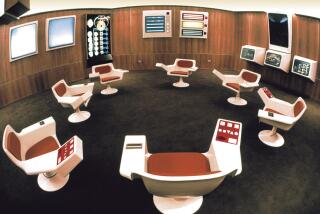Speaking of: : Calculating the Revolution
- Share via
The first one hummed to life in 1945 in a 100-foot-long cabinet. Today, about 148 million of its progeny thrive across the globe--most perched on desks.
The first program helped design the hydrogen bomb. Now, programs organize payrolls, space launches, grocery lists, car production, the newspaper you are holding--and even activists fighting the bomb.
The explosive growth of computers is charted by John E. Young in “Global Network: Computers in a Sustainable Society,” a recent publication by the Worldwatch Institute.
Growth has its drawbacks, Young notes. Computers worldwide use about as much electricity as the entire country of Brazil. PCs alone consume at least 115 billion sheets of paper per year--about 21 sheets per person in the world. And California’s Santa Clara County, home to Silicon Valley, has the largest concentration of hazardous-waste cleanup sites in America, he says.
Still, in a world he characterizes as “stuffed with information but starved for knowledge,” computers work magic by organizing one into the other.
Haves and Have-Nots
The United States has nearly half the world’s computers; they may soon be more numerous than cars. But they’ve made their way everywhere, from Indonesia to Saudi Arabia to China. (Computers per 1,000 people) United States: 265 Australia: 175 Canada: 162 Norway: 153 Denmark: 145 New Zealand: 138 Britain: 134 Switzerland: 133 Sweden: 132 Ireland: 126 Finland: 122 Singapore: 116 France: 111 Belgium: 110 Germany: 104 Netherlands: 97 Austria: 85 Japan: 84 Israel: 81 Taiwan: 68 Italy: 57 Spain: 50 Greece: 47 Portugal: 39 South Korea: 33 Hungary: 24 Saudi Arabia: 22 Mexico: 13 Poland: 12 South Africa: 9 Brazil: 6 Ex-Soviet Union: 4 Philippines: 4 Indonesia: 2 India: 1 China: 1 World: 27 Source: 6th Annual Computer Industry Almanac, 1993.
Early Milestones
More power in a smaller package has been made possible by technology. Intel Corp.’s newest microprocessor, the Pentium, packs more than 3 million transistors onto a thumbnail-size chip.
* 1945: Vacuum tubes, used in first computer.
* 1950s: Transistors
* 1960s: Integrated circuits
* 1971: Microprocessor
More Power
The total power of the world’s computers has leaped eleven-fold in just six years, as measured in MIPS, or millions of instructions per second. Source: Computer Industry Almanac
More to Read
Sign up for Essential California
The most important California stories and recommendations in your inbox every morning.
You may occasionally receive promotional content from the Los Angeles Times.












